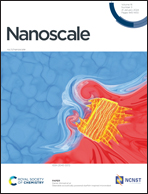Stable room-temperature ferromagnetism and gate-tunable quantum anomalous Hall effect of two-dimensional 5d transition-metal trihalide OsX3 (X = Cl, Br, I) monolayers†
Abstract
5d transition-metal compounds are usually not expected to exhibit distinct magnetic ordering owing to their substantial binding energy associated with 5d electrons. In this study, we demonstrate that two-dimensional (2D) 5d transition-metal Os trihalide OsX3 monolayers can exhibit room-temperature ferromagnetism and quantum anomalous Hall effect (QAHE) by utilizing density functional theory and Monte Carlo simulation. Our calculation results of coexisting Raman and infrared activities of lattice vibration reveal the structural stability of 2D OsX3 (X = Cl, Br, I) and structural instability of 2D OsX3 (X = F). Furthermore, all 2D OsX3 trihalides (X = Cl, Br, I) are half-metals, and their ferromagnetism remains stable under ambient temperature, where 2D OsCl3 and OsBr3 have an in-plane easy axis while 2D OsI3 has an out-of-plane easy axis. Notably, when spin–orbit coupling is included, the gate-tunable QAHE could emerge in ferromagnetic 2D OsI3, while 2D OsCl3 and OsBr3 are topologically trivial. Additionally, the magnon bands of 2D OsX3 (X = Cl, Br, I) possess two spin-wave branches with dispersion similar to that of the Dirac cone in the electronic structure of graphene, which are attributed to the unique ferromagnetic honeycomb sublattice of osmium atoms.



 Please wait while we load your content...
Please wait while we load your content...